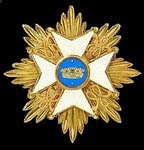This concludes the mini-project as this was the last regular French infantry regiment that fought there, although I may also do the flags of the Volontaires Étrangers who fought at St Cast.
First raised 1635 as Regiment d'Enghien and renamed Bourbon in 1686. Ranked 39th in 1756. Two battalions strong.
Flags carried from at least 1686-1791.
Early history:
Susane lists the regiment's activities in the various civil and other wars of the early 17th century but I shall not recount them here. Kronoskaf here: http://www.kronoskaf.com/syw/index.php?title=Bourbon_Infanterie gives an account of the regiment's many activities in the Nine Years' War, the War of the Spanish Succession and the War of the Austrian Succession based largely on Susane.
Bourbon in the SYW from Susane Volume 6 - my translation:
Bourbon took part in the Saarlouis camp in 1753. It served on the coast of Brittany during the six first campaigns of the Seven Years War. It was particularly distinguished in 1758 in the combat of Saint Cast. At the news of the British landings, the regiment gathered on the 10th September at Lamballe, and the affair took place the next day. It attacked the enemy on the right [flank] and, despite the fire of the enemy ships which swept the beach, it threw the British battalions opposed to it into the sea. The colonel-lieutenant le Marquis de Broc, whose conduct had been most notable, was charged by the Duc d'Aiguillon to carry the news of the victory to Versailles.
At the beginning of 1759 Bourbon was sent to Belle Isle. There it spent two years without being attacked. On the 7th April 1761 115 British ships tried to disembark their troops at Port Andras. The regiment surprised the enemy in the middle of the operation, killed 800 of them, nearly all grenadiers, and made 300 prisoner including a lieutenant colonel and a major. But the British made another attempt on the 21st and were luckier. The lieutenant colonel the Chevalier de Sainte Croix defended with great courage up to the 7th June and did not agree to surrender until he had lost all hope of relief. He obtained an honourable capitulation for the regiment which was transported by British ships to the mainland and sent to Arras. It left that town in December 1763 to go to Dunkirk.
And this was the uniform in 1756:





















